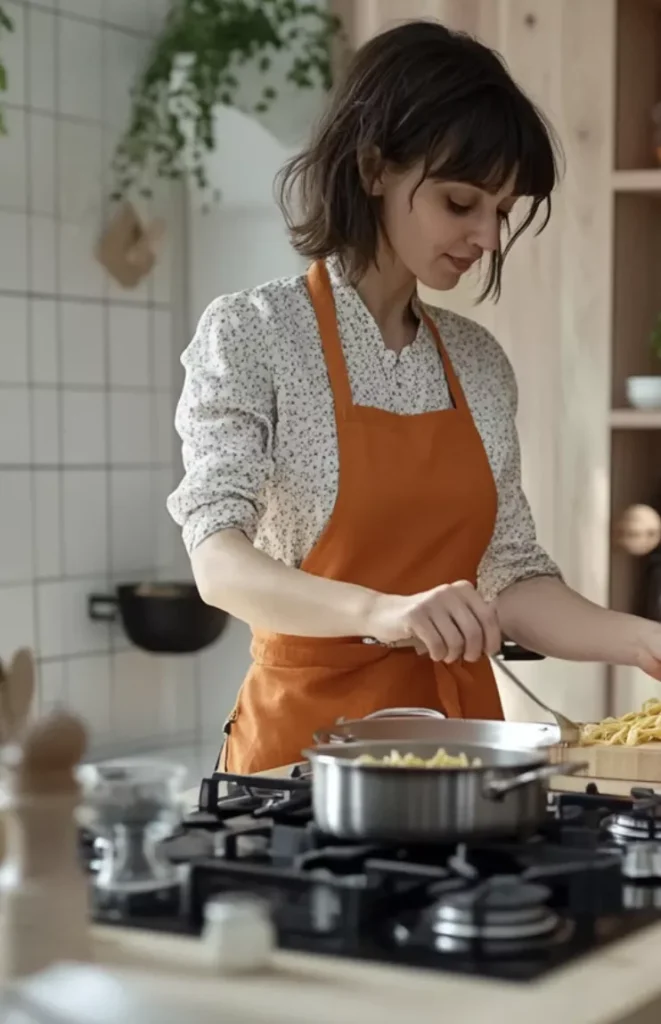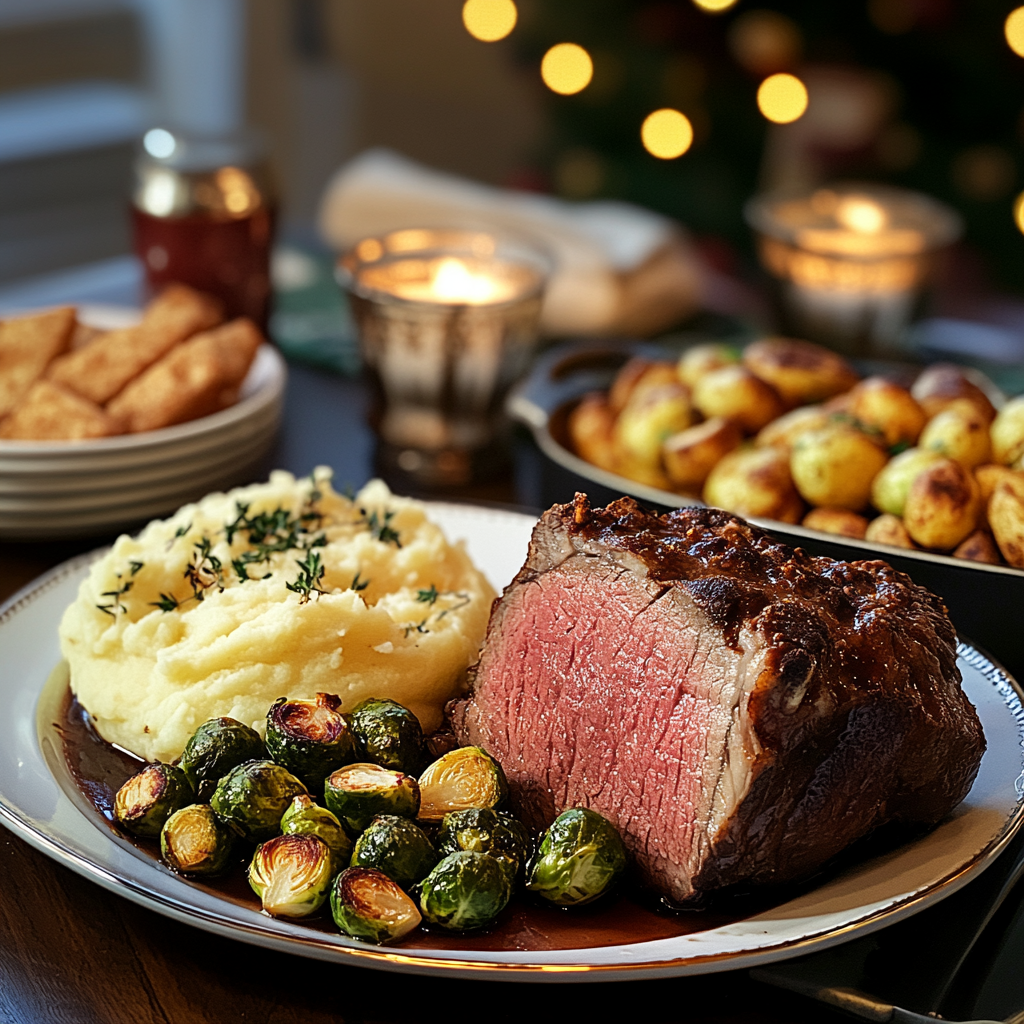The beef boneless rib roast recipe is a timeless favorite in the culinary world, celebrated for its rich flavor and tender texture. This versatile cut of beef is perfect for holiday feasts, family dinners, or special occasions, offering both convenience and elegance. Mastering the preparation and cooking of a boneless rib roast ensures a meal that is both impressive and satisfying. Whether you’re new to cooking roasts or an experienced chef, understanding the nuances of this recipe guarantees success every time.
Table of Contents
ToggleUnderstanding and Preparing the Beef Boneless Rib Roast
What Is a Beef Boneless Rib Roast?
A boneless rib roast comes from the same cut as the prime rib, but with the bones removed. This means you get the same incredible marbling and deep beefy flavor, but with the convenience of easier preparation and slicing. It’s a premium cut that’s often served at celebrations and fancy dinners, thanks to its tenderness and melt-in-your-mouth texture.
Some key characteristics of a boneless rib roast include:
- Rich marbling that enhances flavor and juiciness.
- A tender texture that makes for an easy, satisfying bite.
- A naturally deep, beefy taste that pairs well with a variety of seasonings and cooking methods.
So, whether you’re cooking for a crowd or just a small family dinner, this cut is guaranteed to impress!
How to Choose the Best Boneless Rib Roast
The success of your beef boneless rib roast recipe starts with picking the best-quality meat. Here’s what to look for:
1. Check the Grade of the Beef
In the U.S., beef is graded by the USDA into three main categories:
- Prime: The highest quality, with abundant marbling for extra juiciness. Ideal for special occasions!
- Choice: Slightly less marbled but still tender and flavorful—perfect for home cooks.
- Select: A leaner option with less marbling, which can result in a drier texture if not cooked carefully.
For the best results, aim for Prime or high-end Choice beef.
2. Look for Good Marbling
Marbling refers to the fine white streaks of fat within the meat. Your roast will have more marbling, juicier, and flavor. Avoid cuts that look too lean, as they may lack tenderness.
3. Consider the Size
Plan for ½ to ¾ pound per person when selecting your roast. If you’re serving a large gathering, you might need a 4 to 6-pound roast.
4. Ask Your Butcher for Assistance
If you’re unsure which cut to choose, don’t hesitate to ask your butcher for a well-marbled, evenly shaped boneless rib roast. Some butchers even provide pre-trimmed and tied roasts for easier cooking.
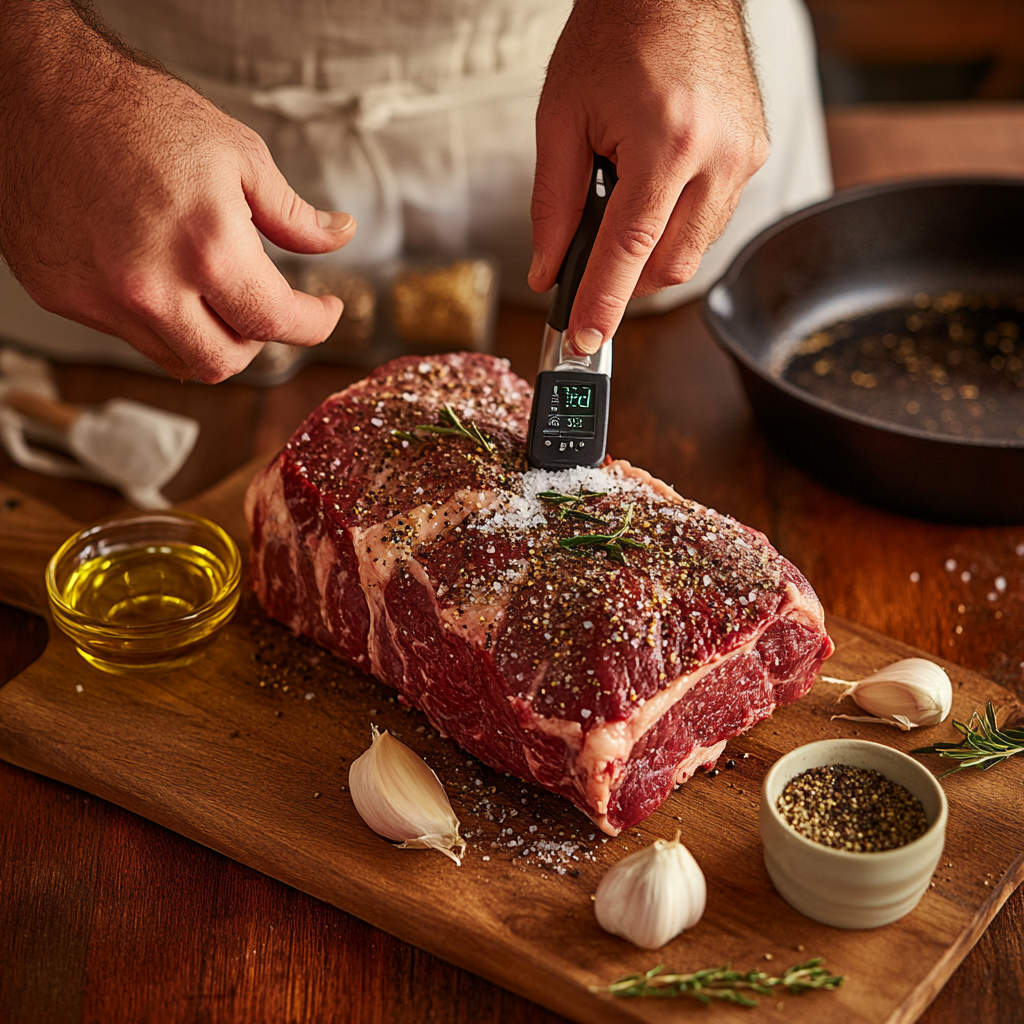
Essential Ingredients for a Flavorful Roast
Before diving into cooking, let’s talk about the ingredients that will elevate your boneless prime rib roast recipe to perfection.
1. Core Ingredients
- Beef Boneless Rib Roast (4–6 lbs.) – The star of the show!
- Kosher Salt – Helps draw out moisture, creating a crispy crust.
- Black Pepper (freshly ground) – Enhances the natural beefy flavor.
- Garlic (minced or powdered) – Adds a deep, aromatic taste.
- Olive Oil or Melted Butter – Helps the seasoning adhere and enhances browning.
2. Optional Flavor Enhancers
- Fresh Herbs (Rosemary & Thyme) – Infuse the roast with a fragrant, earthy aroma.
- Smoked Paprika – Adds a subtle smoky undertone.
- Onion Powder – Boosts savory depth.
- Worcestershire Sauce – Adds umami and richness.
3. Best Oils and Fats for Cooking
- Olive Oil – A great all-purpose choice for seasoning.
- Unsalted Butter – Creates a rich, golden crust.
- Beef Tallow – Enhances the natural beefy taste.
Preparing and Cooking the Rib Roast
How to Prepare the Rib Roast for Cooking
Before you start roasting, proper preparation is key. These steps will ensure your beef boneless rib roast recipe turns out flavorful and tender.
1. Trim and Tie the Roast (If Needed)
- If your butcher hasn’t done this already, trim any excess fat, leaving about ¼ inch of fat on top for added flavor.
- Using butcher’s twine to tie the roast helps it keep a uniform shape, ensuring even cooking.
2. Bring to Room Temperature
- Take the roast out of the fridge at least 1–2 hours before cooking.
- This helps it cook evenly and prevents the outer layer from overcooking before the inside reaches the perfect doneness.
3. Dry Brining vs. Wet Brining
- Dry Brining: Coat the roast in kosher salt and let it rest uncovered in the fridge for 12–24 hours. This enhances the meat’s flavor and helps create a crispy crust.
- Wet Brining: Soak the roast in a saltwater solution with herbs for 12 hours. While this can add moisture, dry brining is preferred for achieving a crispier crust.
Best Cooking Methods for a Juicy Rib Roas
There are a few different ways to cook a boneless rib roast, but these are the most effective for achieving a tender, flavorful result.
1. Oven Roasting (Traditional Method)
This is the most popular method for cooking a rib roast. It creates a rich, caramelized crust while keeping the inside tender and juicy.
Step-by-Step Instructions:
- Preheat the oven to 450°F (232°C).
- Rub the roast with olive oil or melted butter, followed by your preferred seasonings.
- Place the roast on a rack in a roasting pan, fat-side up, to allow the juices to distribute as it cooks.
- Roast at 450°F for 15 minutes to create a flavorful crust.
- Reduce heat to 325°F (163°C) and continue roasting. Use the 15 minutes per pound rule as a general guide.
- Insert a meat thermometer into the thickest part to check the internal temperature (see doneness guide below).
2. Reverse Searing (For Extra Crust and Flavor)
Reverse searing involves slow-roasting the meat first and finishing with a high-heat sear.
How to Reverse Sear a Rib Roast:
- Preheat the oven to 225°F (107°C) and cook the roast until it reaches about 10–15°F below your desired doneness.
- Remove from the oven and let it rest for 30 minutes.
- Heat a skillet or oven to 500°F (260°C) and sear each side of the roast for 1–2 minutes until a deep brown crust forms.
This method locks in flavor and prevents overcooking!
3. Slow Cooking (For Fall-Apart Tender Meat)
If you prefer a fall-apart tender texture, slow-cooking is a great option.
- Season the roast and place it in a slow cooker with beef broth, garlic, onions, and herbs.
- Cook on low for 6–8 hours or until the internal temperature reaches 135°F (57°C) for medium-rare.
- Remove and let it rest before slicing.
Recommended Seasonings and Marinades
Choosing the right seasonings can elevate your beef boneless rib roast recipe. Here are a few tried-and-true seasoning blends.
Classic Garlic & Herb Crust
- 2 tbsp kosher salt
- 1 tbsp black pepper
- 4 cloves garlic, minced
- 2 tbsp fresh rosemary, chopped
- 2 tbsp olive oil or melted butter
Bold & Smoky Rub
- 2 tbsp smoked paprika
- 1 tbsp garlic powder
- 1 tbsp onion powder
- 1 tsp cayenne pepper
- 1 tbsp brown sugar
Simply rub the seasoning mix onto the roast before cooking for a flavor-packed bite!
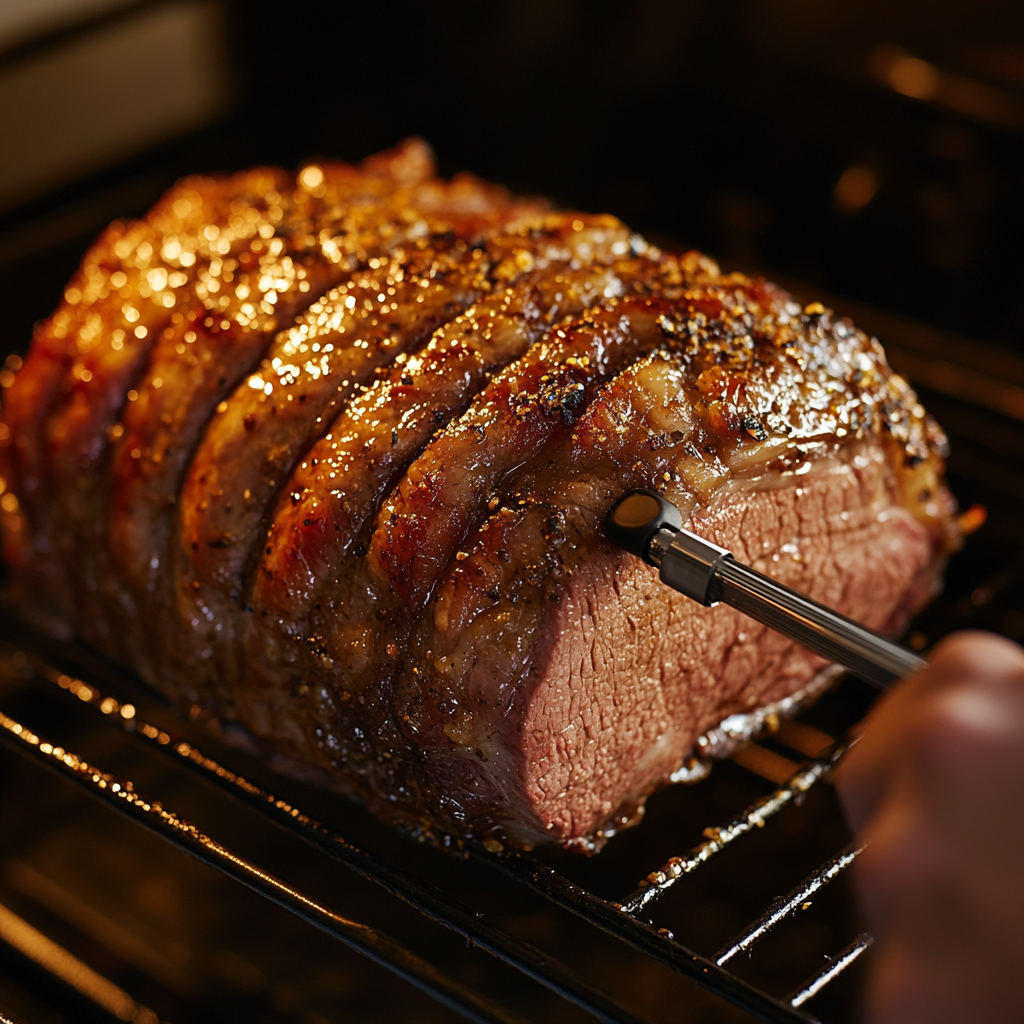
Cooking, Serving, and Storing Your Rib Roast
Step-by-Step Cooking Instructions
To ensure the best results, follow these detailed cooking instructions:
- Preheat the oven and prepare your roast as outlined in Part 2.
- Use a meat thermometer to monitor internal temperature.
- Cook according to the weight of the roast, adjusting for the desired doneness.
- Allow the meat to rest before slicing to preserve its juices.
How to Achieve the Perfect Doneness
Use the following temperature guide for your preferred doneness:
| Doneness | Internal Temperature (°F) | Internal Temperature (°C) |
|---|---|---|
| Rare | 120–125°F | 49–52°C |
| Medium Rare | 130–135°F | 54–57°C |
| Medium | 140–145°F | 60–63°C |
| Medium Well | 150–155°F | 65–68°C |
| Well Done | 160°F+ | 71°C+ |
Always remove the roast 5–10°F before the target temperature, as it will continue to cook while resting.
Resting, Carving, and Serving the Roast
Once your beef boneless rib roast is cooked to perfection, follow these final steps:
1. Resting
- Let the roast rest for 15–20 minutes before slicing. By allowing the juices to redistribute, the meat stays moist.
2. Carving
- Use a sharp carving knife and cut against the grain into thick or thin slices, depending on preference.
3. Best Side Dishes
- Creamy garlic mashed potatoes
- Roasted Brussels sprouts
- Yorkshire pudding (a classic pairing!)
Storage and Reheating Tips
1. Storing Leftovers
- Tightly wrap the roast in foil or store it in an airtight container.
- Store in the fridge for 3–4 days or freeze for up to 3 months.
2. Reheating Without Drying Out
- Oven Method: Preheat to 250°F (120°C), wrap the slices in foil, and warm for 10–15 minutes.
- Skillet Method: Sear briefly on low heat with a splash of beef broth.
- Avoid the Microwave: It can make the meat tough and rubbery.
Frequently Asked Questions (FAQs)
When cooking a beef boneless rib roast, many home cooks have similar concerns. Below are some of the most common questions and expert answers to ensure your roast turns out perfectly every time.
1. How Long Should I Cook a Boneless Rib Roast Per Pound?
The general rule is 15–20 minutes per pound at 325°F (163°C) after an initial high-heat sear. However, the best way to ensure accuracy is to use a meat thermometer and follow this guide:
| Weight | Cooking Time (Medium-Rare) | Cooking Time (Medium) |
|---|---|---|
| 3 lbs. | 45–60 min | 60–75 min |
| 4 lbs. | 60–80 min | 80–100 min |
| 5 lbs. | 75–100 min | 100–120 min |
Always let the roast rest for at least 15 minutes before slicing to lock in juices.
2. What’s the Best Way to Keep My Rib Roast Juicy?
To ensure a tender and juicy roast:
- Dry brine with salt at least 12–24 hours before cooking.
- Sear at high heat first, then slow roast at a lower temperature.
- Let the meat rest after cooking to prevent juices from escaping when slicing.
- Use a thermometer to avoid overcooking.
3. Can I Cook a Beef Boneless Rib Roast in an Air Fryer?
Yes, you can! An air fryer provides a crispy crust while keeping the inside tender.
How to Cook a Boneless Rib Roast in an Air Fryer:
- Preheat the air fryer to 400°F (204°C).
- Rub the roast with olive oil, garlic, rosemary, salt, and pepper.
- Place the roast in the air fryer basket and cook at 400°F for 15 minutes.
- Reduce the heat to 300°F (149°C) and cook until the internal temperature reaches 130°F for medium-rare.
- Rest for 15 minutes before slicing.
This method is great for smaller roasts (2–3 lbs.) but may not be ideal for larger cuts.
4. How Do I Make a Crispy Crust on My Rib Roast?
To get that perfect golden-brown crust, follow these tips:
- Pat the roast dry before seasoning to help create a crispier outer layer.
- Sear at high heat (450°F for 15 minutes) before lowering the temperature.
- Use butter or olive oil to enhance browning.
- Reverse-sear method: Cook slowly at 225°F, then sear at 500°F for the last few minutes.
For even more delicious recipes, check out our Taste of Nonna recipe collection!
Creative Ways to Use Leftover Rib Roast
Leftover beef boneless rib roast can be just as delicious as the original meal! Instead of simply reheating, try these creative ways to repurpose your leftovers into new and exciting dishes.
1. Classic Beef Sandwiches
Turn your roast into a mouthwatering prime rib sandwich:
- Slice the roast thinly and warm it gently in beef broth.
- Serve on a crusty baguette or brioche bun.
- Top with horseradish sauce, caramelized onions, and melted provolone.
This makes for a quick and hearty lunch that’s packed with flavor!
2. Homemade Beef Stroganoff
Use your rib roast to create a creamy, comforting beef stroganoff:
- Sauté onions, mushrooms, and garlic in butter.
- Add sliced roast beef and cook briefly.
- Stir in sour cream, Dijon mustard, and beef broth to make a rich sauce.
- Serve over egg noodles or mashed potatoes.
This dish is easy to make in under 30 minutes and tastes amazing!
3. Rib Roast Tacos
Give your leftover rib roast a Mexican twist:
- Chop the roast into small pieces and reheat in a skillet with taco seasoning.
- Serve on warm tortillas with toppings like guacamole, fresh cilantro, and diced onions.
- Squeeze some lime juice over it for extra freshness.
This is a fun and flavorful way to transform your leftovers into something exciting.
Expert Tips to Elevate Your Rib Roast
Even if you’ve mastered the basics, a few expert techniques can take your beef boneless rib roast recipe to the next level. Let’s dive into some pro-level tips that will enhance the flavor, texture, and overall presentation of your roast.
1. Use a Meat Thermometer for Precision
Cooking times can vary based on the size of your roast and oven temperature fluctuations. The best way to ensure perfect doneness is by using a digital meat thermometer. Insert it into the thickest part of the roast, avoiding any fat or bone.
Ideal Temperature Ranges:
- Rare: 120–125°F (49–52°C)
- Medium-Rare: 130–135°F (54–57°C)
- Medium: 140–145°F (60–63°C)
- Medium-Well: 150–155°F (65–68°C)
Pro Tip: Always remove your roast from the oven 5–10°F before your target temperature, as it will continue cooking while resting.
2. Dry Brining for Maximum Flavor
One of the easiest ways to enhance the natural beefy taste is dry brining. This method helps the meat absorb salt, breaking down muscle fibers for a juicier, more tender roast.
How to Dry Brine:
- Generously rub the roast with kosher salt at least 12–24 hours before cooking.
- Set it on a wire rack over a baking sheet and refrigerate uncovered.
- Before roasting, pat dry and apply seasonings.
Dry brining also helps achieve that beautiful, crispy crust we all love!
3. Baste with Herb Butter for Extra Flavor
Halfway through roasting, basting with herb-infused butter adds richness and depth to your roast.
Simple Herb Butter Recipe:
- ½ cup unsalted butter, melted
- 2 cloves garlic, minced
- 1 tbsp fresh rosemary, chopped
- 1 tbsp fresh thyme, chopped
Brush this mixture over the roast every 20–30 minutes while it cooks. This enhances the golden-brown crust and infuses it with aromatic goodness.
4. Resting for the Perfect Slice
Skipping the resting phase is one of the biggest mistakes home cooks make. If you slice into the roast immediately, the juices will run out, leaving your meat dry.
Best Practice:
- Rest the roast loosely covered with foil for at least 15–20 minutes before carving.
- This allows the juices to redistribute, ensuring that every slice is moist and flavorful.
5. Carve Against the Grain for Tenderness
The way you slice your boneless beef rib roast impacts its texture. Cutting against the grain shortens muscle fibers, making each bite more tender.
How to Carve Perfectly:
- Use a sharp carving knife for clean slices.
- The way you slice your boneless beef rib roast impacts its texture.
- Slice into ½-inch thick pieces for the best texture.
By following these expert techniques, you can transform a great roast into an unforgettable meal!
Common Mistakes to Avoid
Even seasoned cooks can make mistakes when preparing a beef boneless rib roast recipe. Avoiding these errors will help ensure your roast is juicy, flavorful, and cooked to perfection.
1. Cooking Straight from the Refrigerator
If you roast cold meat, the outer layer will overcook while the inside remains undercooked.
Fix: Always let the meat sit at room temperature for 1–2 hours before cooking.
2. Not Using a Meat Thermometer
Guessing doneness by cooking time alone can lead to overcooked or undercooked meat.
Fix: Use a digital meat thermometer to check the internal temperature and ensure perfect doneness.
3. Overseasoning or Overseasoning Too Late
Applying salt just before roasting doesn’t allow enough time for flavors to penetrate the meat. Similarly, using too many overpowering seasonings can mask the natural beef flavor.
Fix: Dry brine the roast at least 12 hours in advance, and keep seasonings simple—salt, pepper, garlic, and herbs work best.
4. Cooking at Too High a Temperatur
Roasting at too high a heat can result in a burnt crust and a raw center.
Fix: Always start at 450°F for 15 minutes, then reduce to 325°F for slow, even cooking.
5. Skipping the Resting Period
Cutting into the roast immediately after cooking causes the juices to leak out, making the meat dry.
Fix: Let the roast rest for at least 15 minutes to retain moisture.
6. Slicing the Roast Incorrectly
Slicing with the grain results in chewy, tough meat.
Fix: Always carve against the grain for tender, easy-to-chew slices.
Best Side Dishes and Wine Pairing
A perfectly cooked beef boneless rib roast deserves equally delicious side dishes and a well-paired wine. The right accompaniments can enhance the flavors of the roast, creating a well-balanced meal that leaves a lasting impression.
1. Best Side Dishes for a Rib Roast
The rich, beefy flavors of a rib roast pair well with savory, creamy, and slightly tangy sides. Here are some classic and creative options:
Classic Side Dishes
- Garlic Mashed Potatoes – Creamy and buttery, they complement the roast’s richness.
- Yorkshire Pudding – A traditional pairing that soaks up the flavorful juices.
- Creamed Spinach – Adds a creamy, slightly tangy contrast to the beef.
- Roasted Brussels Sprouts with Bacon – The smoky, crispy bacon enhances the caramelized sprouts.
- Horseradish Cream Sauce – Its zesty kick cuts through the richness of the meat.
Lighter and Healthier Options
- Roasted Root Vegetables – Carrots, parsnips, and sweet potatoes add a natural sweetness.
- Steamed Asparagus with Lemon Butter – A fresh, zesty contrast to the beef.
- Mixed Greens with Balsamic Vinaigrette – A light salad balances out the meal’s heaviness.
Nutritional Value and Health Benefits
While a beef boneless rib roast recipe is known for its rich, indulgent flavor, it also provides essential nutrients that make it a valuable part of a balanced diet. Let’s break down the nutritional profile and health benefits of this premium cut.
1. Nutritional Breakdown of a Boneless Rib Roast
A typical 3-ounce serving of boneless rib roast (before cooking) contains:
| Nutrient | Amount | % Daily Value (DV) |
|---|---|---|
| Calories | 250–300 kcal | 15% |
| Protein | 22–25g | 50% |
| Total Fat | 18–22g | 28% |
| Saturated Fat | 8–10g | 40–50% |
| Cholesterol | 70mg | 23% |
| Iron | 2.5mg | 14% |
| Zinc | 6mg | 55% |
Note: The exact values may vary based on the cut, marbling, and cooking method.
2. Health Benefits of Rib Roast
While beef boneless rib roast is often seen as a luxury cut, it also has several health benefits when consumed in moderation.
Rich in High-Quality Protein
- Helps build and repair muscles.
- Keeps you feeling full longer, reducing unnecessary snacking.
Good Source of Iron and Zinc
- Iron supports oxygen transport in the blood, preventing fatigue.
- Zinc helps strengthen the immune system and supports wound healing..
Contains Beneficial Fats
- While it has saturated fat, rib roast also contains monounsaturated fats, which can help support heart health when consumed in moderation.
Supports Brain Function
- Beef contains B vitamins (especially B12), which help with energy production and brain function.
3. How to Make Rib Roast a Healthier Choice
If you want to enjoy a beef boneless rib roast recipe while keeping it balanced, here are some tips:
- Trim excess fat before cooking to reduce overall fat intake.
- Opt for grass-fed beef, which has higher omega-3 fatty acids and antioxidants.
- Pair with fiber-rich vegetables to improve digestion.
- Control portion sizes—stick to a 4–6 oz. serving per meal.
By making small adjustments, you can enjoy this indulgent dish without overloading on unhealthy fats and calories.
Final Thoughts
A beef boneless rib roast is more than just a meal—it’s an experience. From choosing the right cut and seasoning it properly to pairing it with the best sides and wine, every step contributes to a flavorful and memorable dining experience. Plus, when eaten in moderation, it provides essential nutrients like protein, iron, and B vitamins that support overall health.
Whether you’re preparing this dish for a special occasion or a family dinner, following the right techniques will ensure a perfectly cooked, tender, and juicy roast every time.
For more delicious recipes, check out Taste of Nonna and discover new ways to elevate your cooking! 🍽️
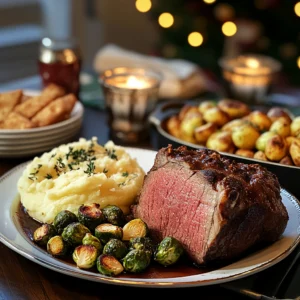
Beef Boneless Rib Roast Recipe: A Guide to the Perfect Roast Dinner
Ingredients
- 1 beef boneless rib roast (4–5 pounds)
- 3 tablespoons olive oil
- 1 tablespoons kosher salt
- 2 teaspoons freshly ground black pepper
- 2 teaspoons garlic powder
- 2 teaspoons onion powder
- 1 tablespoon fresh rosemary chopped
- 1 tablespoon fresh thyme chopped
Optional Additions:
- 1 tsp smoked paprika for extra depth
- 1 tsp onion powder for extra savoriness
- 1 tbsp Worcestershire sauce for umami richness
Instructions
Step 1: Prepare the Roast
- 1. Bring to Room Temperature: Take the rib roast out of the fridge 1–2 hours before cooking. This ensures even cooking.
- 2. Season Generously: Rub the roast with olive oil or melted butter, then coat it evenly with salt, pepper, garlic, rosemary, and thyme. If using, add smoked paprika and onion powder for extra flavor.
- 3. Dry Brine (Optional but Recommended): For maximum flavor, season the roast and let it rest uncovered in the fridge for 12–24 hours.
Step 2: Choose Your Cooking Method
Oven-Roasting Method (Traditional & Foolproof)
- 1. Preheat the oven to 450°F (232°C).
- 2. Sear the Roast: Place the roast in a roasting pan with a rack, fat-side up. Roast for 15 minutes to create a golden crust.
- 3. Reduce Temperature: Lower the oven to 325°F (163°C) and continue roasting. Use the 15 minutes per pound rule as a general guide.
- 4. Check Internal Temperature: Insert a meat thermometer into the thickest part of the roast:
- – Rare: 120–125°F (49–52°C)
- – Medium Rare: 130–135°F (54–57°C)
- – Medium: 140–145°F (60–63°C)
- – Well Done: 160°F+ (71°C+)
Reverse-Sear Method (For the Best Crust & Even Cooking)
- 1. Preheat the oven to 225°F (107°C) and slow-roast until the internal temperature is 10°F below your desired doneness.
- 2. Remove and let rest for 30 minutes.
- 3. Sear at High Heat: Heat a cast-iron skillet or oven to 500°F (260°C) and sear each side for 1–2 minutes until a deep brown crust forms.
Slow-Cooker Method (For a Fall-Apart Tender Roast)
- 1. Place the seasoned roast in a slow cooker with 1 cup beef broth, 1 onion (sliced), and 2 cloves garlic.
- 2. Cook on Low for 6–8 hours or until tender.
- 3. Sear in a skillet for 2–3 minutes before serving for added texture.
- Step 3: Resting and Carving
- 1. Let the roast rest for 15–20 minutes before slicing. This keeps the juices inside, making the meat more tender.
- 2. Use a sharp carving knife and slice against the grain for the most tender bites.
Serving Suggestions
- Pair your beef boneless rib roast with classic and flavorful side dishes:
- Garlic mashed potatoes (rich and creamy)
- Roasted Brussels sprouts with bacon (crispy and smoky)
- Yorkshire pudding (a traditional pairing)
- Red wine jus (for an elegant touch)
- For the best wine pairing, choose Cabernet Sauvignon, Malbec, or Syrah to complement the beef’s bold flavors.
Notes
Storage and Reheating Tips
Storing Leftovers:
- Refrigerate in an airtight container for up to 4 days.
- Freeze slices for up to 3 months for later use.
Reheating Without Drying Out:
- Oven Method: Wrap in foil and warm at 250°F (120°C) for 10–15 minutes.
- Skillet Method: Sear briefly on low heat with a splash of beef broth.
- Avoid the Microwave: It can make the meat tough and

